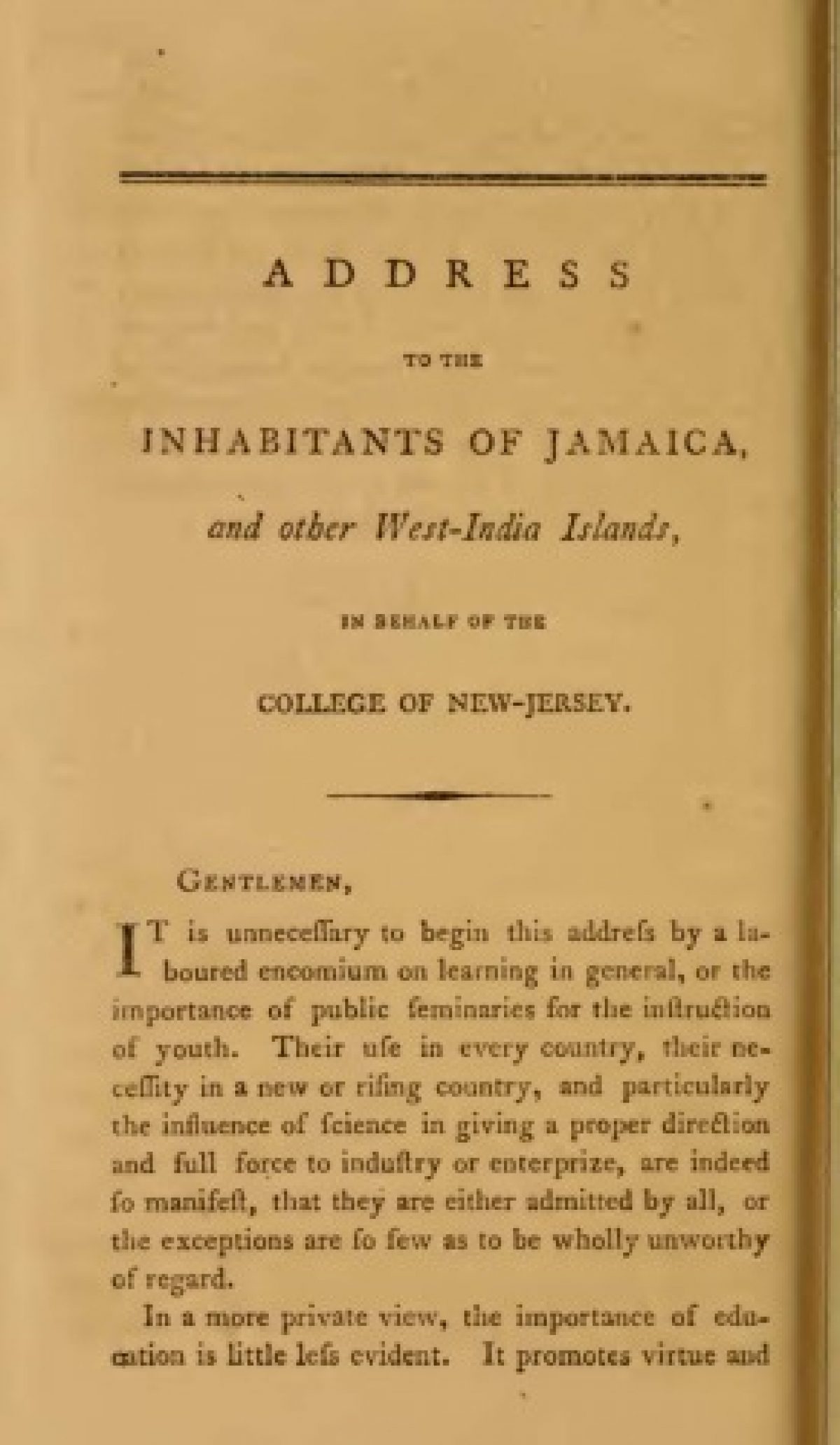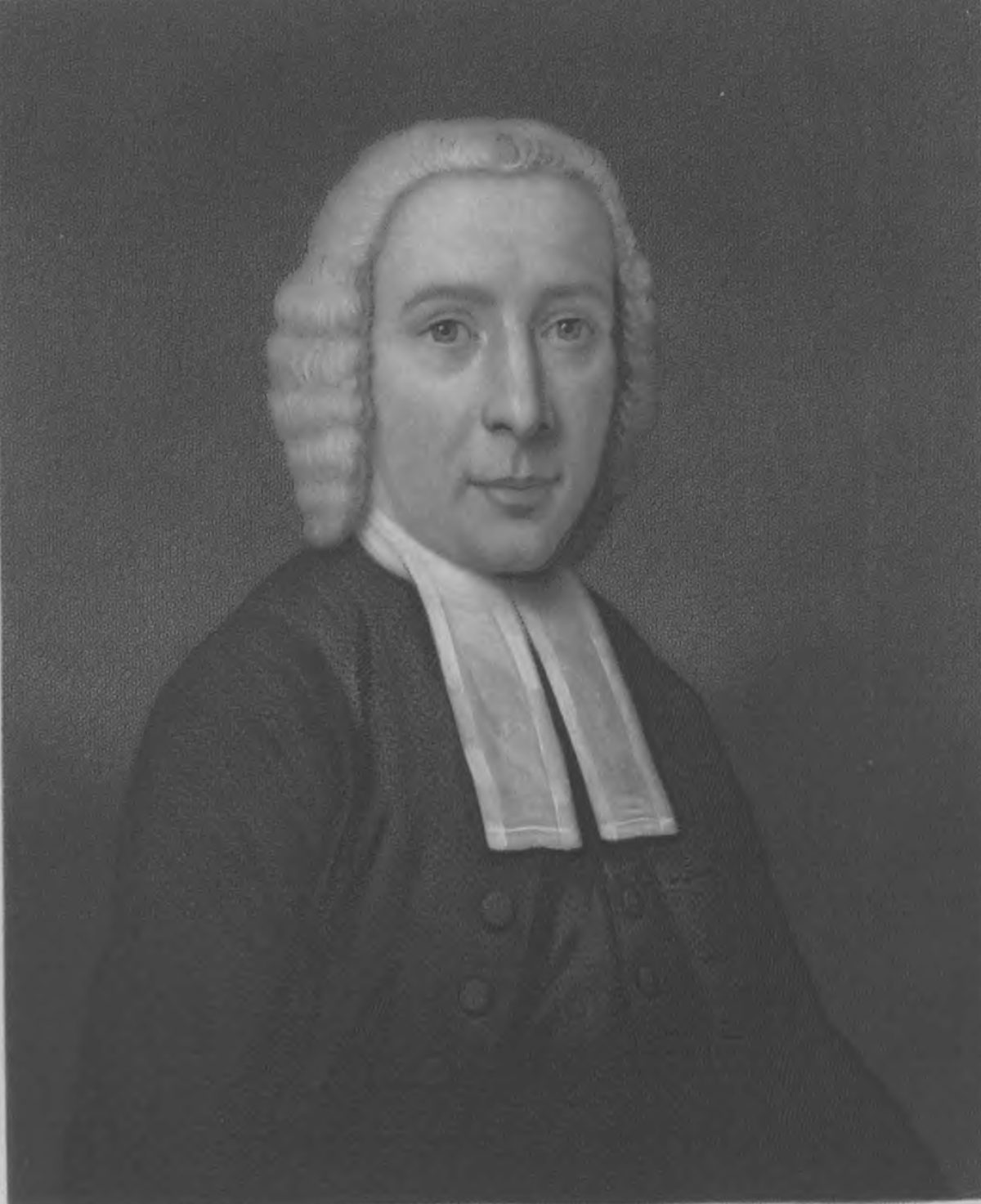[1]
Craig Steven Wilder, Ebony & Ivy: Race, Slavery and the Troubled History of America’s Universities (New York: Bloomsbury Press, 2013), 81.
⤴
[2]
John Witherspoon, “Address to the Inhabitants of Jamaica, and other West-India Islands, in Behalf of the College of New Jersey,” in The Works of John Witherspoon, D.D., Vol. VIII (Edinburgh: J. Ogle, 1815).
⤴
[4]
John Vardill, “Response to Witherspoon Address,” (1772), New Jersey Archives, Vol. 28 (1772-1773), 345-359.
⤴
[5]
Wilder, Ebony and Ivy, 105.
⤴
[6]
Minutes of a Meeting of the Trustees of the College of New Jersey, March 11, 1772. 1748-1777; Board of Trustees Records, Volume 1A; Princeton University Archives, Department of Rare Books and Special Collections, Princeton University Library, 184-186.
⤴
[7]
Minutes of a Meeting of the Trustees of the College of New Jersey, September 30, 1772. 1748-1777; Board of Trustees Records, Volume 1A; Princeton University Archives, Department of Rare Books and Special Collections, Princeton University Library, 189.
⤴
[8]
Prior to the fundraising campaign, there were few students from the Caribbean region on campus. Simon Williams, class of 1766, was a clergyman from Ireland who lived in Jamaica before coming to study in Princeton. Lewis Feuilleteau Wilson, who would graduate the year after the trip in 1773 and become a college tutor until 1775, was from a wealthy planter family on St. Christopher (now known as Saint Kitts) in the British West Indies.
See: James McLachlan, Princetonians: A Biographical Dictionary, 1748-1768 (Princeton, NJ: Princeton University Press, 1978), 448; Richard A. Harrison, Princetonians: A Biographical Dictionary, 1769-1775 (Princeton, NJ: Princeton University Press, 1980), 352.
⤴
[9]
Harrison, Princetonians: A Biographical Dictionary, 1776-1783, 254.
⤴
[10]
Students Peter Perrier and Auguste Guibert both listed their place of origin as San Domingo, and both left the college in 1798 without graduating. In the late 1850s, Augustus Armagnac listed independent Haiti as his place of origin. He graduated with an A.B. in 1861, A.M. in 1872, and an honorary Ph.D. in 1885, all from Princeton, and became a professor at several other institutions. William M. Williams, who only indicated he was from the West Indies, left the college without graduating in 1810, as did Jonathan Henry (Harvey) Hodges from the British colony of Anguilla in 1817.
See: Perrier, Peter M.; 1801; Undergraduate Alumni Records, Box Non-graduate card file; Princeton University Archives, Department of Rare Books and Special Collections, Princeton University Library. Guibert, Auguste; 1802; Undergraduate Alumni Records, Box Non-graduate card file; Princeton University Archives, Department of Rare Books and Special Collections, Princeton University Library. Armagnac, Augustus; 1861; Undergraduate Alumni Records, Box 119; Princeton University Archives, Department of Rare Books and Special Collections, Princeton University Library. Williams, William M.; 1814; Undergraduate Alumni Records, Box Non-graduate card file; Princeton University Archives, Department of Rare Books and Special Collections, Princeton University Library. Hodge, Jonathan Henry; 1820; Undergraduate Alumni Records, Box Non-graduate card file; Princeton University Archives, Department of Rare Books and Special Collections, Princeton University Library.
⤴
[11]
Ruan, John; 1790; Undergraduate Alumni Records, Series I, Box 51; Princeton University Archives, Department of Rare Books and Special Collections, Princeton University Library.
⤴
[13]
Ruth L. Woodward and Wesley Frank Craven, Princetonians, 1784-1790: A Biographical Dictionary (Princeton, NJ: Princeton University Press, 1991), 517-518.
⤴
[15]
1820 St. Croix Residents Database, St. Croix African Roots Project, accessed 17 July 2017, www.visharoots.org.
There were five other Princeton students from wealthy sugar plantation owning families on St. Croix. Christian DeWint and Peter Markoe were admonished and left the college in 1788, while Peter’s younger brother Francis Markoe graduated in 1791. Isaac Hartman and Samuel VanBrackle left the college in 1795 and 1806, respectively, without graduating. See: Woodward and Craven, Princetonians, 1784-1790, 363-365. J. Jefferson Looney and Ruth L. Woodward, Princetonians, 1791-1794: A Biographical Dictionary(Princeton, NJ: Princeton University Press, 1991), 73-76. Hartman, Isaac; 1795; Undergraduate Alumni Records, Series I, Box 60; Princeton University Archives, Department of Rare Books and Special Collections, Princeton University Library. VanBrackle, Samuel H.; 1808; Undergraduate Alumni Records, Box Non-graduate card file; Princeton University Archives, Department of Rare Books and Special Collections, Princeton University Library.
⤴
[16]
Raven (Ravens), Lawrence L.; 1797; Undergraduate Alumni Records, Series I, Box 61; Princeton University Archives, Department of Rare Books and Special Collections, Princeton University Library.
⤴
[17]
Salomons, Dirck; 1807; Undergraduate Alumni Records, Box 68; Princeton University Archives, Department of Rare Books and Special Collections, Princeton University Library.
⤴







